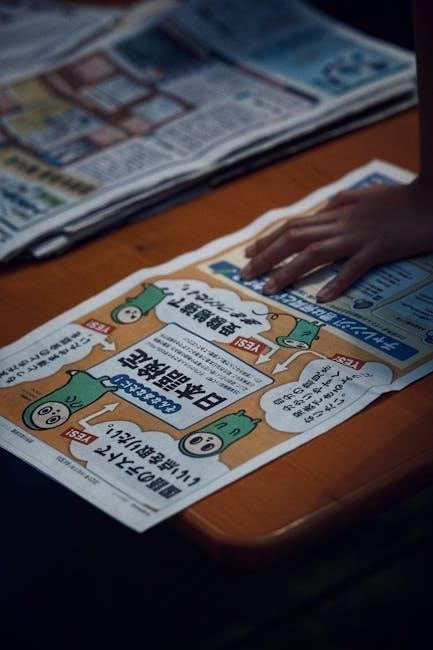Story elements anchor charts are visual tools that help students identify and understand key components of a story, such as characters, setting, and plot, enhancing comprehension and engagement.
What Are Story Elements?
Story elements are the building blocks of a narrative, including characters, setting, plot, point of view, and theme. They provide structure and meaning to a story, helping readers understand the author’s message. Characters are the people or beings in the story, while the setting is the time and place where events occur. The plot is the sequence of events, and the theme is the underlying message. These elements work together to create a cohesive and engaging story.
The Importance of Anchor Charts in Teaching Story Elements
Anchor charts are essential tools for teaching story elements, as they provide a clear and visual representation of concepts like characters, setting, and plot. These charts act as a guide, helping students recognize and understand the structure of a story. They also promote active learning by encouraging students to engage with the material, improving retention and comprehension. Anchor charts make complex ideas accessible and serve as a shared reference point for class discussions and activities.

Key Components of a Story Elements Anchor Chart
A story elements anchor chart typically includes characters, setting, plot, point of view, and theme, serving as a visual guide to understanding and analyzing stories effectively.
Characters: Understanding Protagonists and Antagonists
Characters are the heart of any story, with protagonists driving the narrative and antagonists creating conflict. Anchor charts help students identify character traits, motivations, and relationships, fostering deeper understanding. Visual aids like charts enable learners to track character development and analyze interactions, enhancing comprehension of their roles in advancing the plot and themes.
Setting: Time and Place in a Story
Setting refers to the time and place where a story unfolds, shaping its mood and context. Anchor charts visually represent these elements, helping students identify how the environment influences characters and plot. By highlighting key details like era, location, and cultural background, these charts enable learners to better understand the story’s atmosphere and its impact on the narrative’s progression and character development.
Plot: The Sequence of Events
Plot is the sequence of events that make up a story, guiding the narrative from beginning to end. Anchor charts help students map out the exposition, rising action, climax, falling action, and resolution; Visual tools like plot diagrams allow learners to track how events unfold, ensuring a clear understanding of how conflicts arise and are resolved, making the story’s structure more accessible and engaging for young readers to analyze and discuss.
Point of View: Narrative Perspectives
Point of view refers to the narrative perspective from which a story is told, such as first person, third person limited, or omniscient. Anchor charts can define these terms and provide examples, helping students identify and analyze how the narrator’s perspective shapes the story. By visualizing different viewpoints, learners gain insight into how characters’ thoughts and feelings are conveyed, enhancing their understanding of the narrative and its emotional impact.
Theme: The Underlying Message of the Story
The theme is the central idea or message conveyed by a story, often reflecting universal truths or lessons. Anchor charts can help students identify themes by providing examples and guiding questions, such as asking how characters’ actions or events relate to broader ideas. By analyzing themes, learners connect stories to real-life experiences, fostering deeper comprehension and appreciation of the author’s intent and the story’s significance.
How to Create an Effective Story Elements Anchor Chart
Creating an effective story elements anchor chart involves using clear visuals, concise definitions, and interactive elements. Make it engaging with student input and example charts for better understanding.
Designing a Visual and Organized Layout
A visually appealing and organized layout is crucial for an effective story elements anchor chart. Use clear headings, images, and colors to differentiate sections. Incorporate bullet points for key details and leave white space to avoid clutter. Consider adding icons or symbols to represent each story element, such as a map for setting or a character silhouette for protagonists. This design ensures the chart is easy to follow and engages students effectively during lessons.
Incorporating Student Input and Ideas
Involving students in the creation of anchor charts fosters engagement and ownership. Encourage collaborative brainstorming sessions where students share their thoughts on story elements. Use their ideas to fill in sections, ensuring the chart reflects their understanding. This process not only personalizes learning but also helps students see the relevance of the concepts. Incorporating diverse perspectives enriches the chart and makes it a meaningful classroom resource for all learners.
Using Anchor Charts to Enhance Reading Comprehension
Anchor charts serve as visual guides, helping students recognize and analyze story elements. They provide a reference point for identifying characters, settings, and plot, making comprehension more structured and accessible. Interactive activities, such as guided reading and story retelling, are enhanced by these charts, allowing students to engage deeply with texts and develop a clearer understanding of narrative structures and themes.
Guided Reading Strategies with Anchor Charts
Anchor charts are invaluable during guided reading, providing a visual framework for students to identify and analyze story elements. Teachers can use these charts to model strategies like identifying characters, setting, and plot. By referencing the chart, students learn to recognize patterns and relationships within the story. Interactive activities, such as retelling the story or summarizing key events, become more focused and effective. This approach encourages active participation, deeper comprehension, and the ability to track understanding as students engage with the text.
Independent Reading Activities
Independent reading activities with anchor charts empower students to apply their knowledge of story elements. After guided instruction, students can use anchor charts to identify characters, settings, and plot points in their own reading materials. They can create summaries, analyze themes, or map out story structures. This fosters self-directed learning, allowing students to reinforce their understanding and make meaningful connections to the text independently. This approach enhances retention and deepens comprehension skills.
Teaching Story Elements Through Interactive Activities
Interactive activities like role-playing and retelling stories engage students, helping them visualize and understand characters, settings, and plots while fostering collaboration and deeper comprehension of story elements.
Role-Playing and Story Retelling
Role-playing and story retelling are dynamic activities that engage students deeply with story elements. By acting out characters and events, students develop a personal connection to the narrative. Retelling stories encourages active recall and understanding of plot sequences. These methods enhance collaboration and creativity, making learning enjoyable. They also align with anchor charts, helping students organize their thoughts and identify key elements effectively.
Visualizing and Summarizing
Visualizing and summarizing are powerful strategies that deepen students’ understanding of stories. Anchor charts provide a framework for students to sketch scenes and identify key details, fostering visual literacy. Summarizing encourages students to condense plots and themes into concise statements, improving comprehension and retention. These techniques, supported by anchor charts, help students engage actively with texts and develop critical thinking skills in a structured and creative way.

Benefits of Anchor Charts for Students and Teachers
Anchor charts make learning interactive and visually engaging, simplifying complex concepts. They serve as reference points, aiding retention and guiding instruction, while fostering engagement and participation.
Improved Understanding and Retention of Story Elements
Anchor charts provide a clear, visual breakdown of story elements, making complex concepts easier to grasp. By organizing information in a structured format, they help students retain key details about characters, settings, and plot. The repetition of these visual cues reinforces learning, ensuring students can reference and apply their knowledge effectively. This approach also aids in making connections between story elements, fostering a deeper understanding of the narrative.
Enhanced Engagement and Participation
Anchor charts foster active participation by making learning interactive and accessible. Students engage more deeply with stories when they can visually track characters, settings, and plot developments. Collaborative activities, such as contributing to class charts, encourage teamwork and discussion. This hands-on approach motivates students to take ownership of their learning, making the study of story elements more dynamic and enjoyable. It also helps quieter students share their ideas in a structured format.

Examples of Story Elements Anchor Charts
Examples include character trait charts, plot diagrams, and setting visualizers. These tools provide clear, organized templates for students to analyze and understand story components effectively.
Character Trait Charts
Character trait charts are visual aids that help students identify and analyze the emotions, motivations, and behaviors of protagonists and antagonists. These charts often include key traits like bravery, kindness, or greed, alongside examples from the text. Students can use these charts to track character development, understand conflicts, and make connections between actions and outcomes. By organizing information visually, trait charts make complex characters more accessible and engaging for young readers.
Plot Diagrams
Plot diagrams are essential tools for visualizing the sequence of events in a story. These diagrams typically include sections for exposition, rising action, climax, falling action, and resolution. By mapping out the narrative structure, students can better understand how events unfold and relate to one another. Plot diagrams also help identify key turning points and themes, making complex stories more accessible and engaging for young readers to analyze and discuss.
Customizing Anchor Charts for Different Grade Levels
Anchor charts can be tailored to suit various grade levels, with simpler designs for younger students and more detailed, complex charts for older learners.
Elementary School Adaptations
For elementary students, anchor charts are simplified with bright visuals and large fonts. Teachers use color-coding and images to make concepts like characters, setting, and plot engaging. Interactive elements, such as stickers or movable pieces, help young learners participate actively. Charts are often created collaboratively during lessons, allowing students to match story elements with examples from their reading. This hands-on approach makes abstract concepts concrete and fun for early learners.
Middle and High School Extensions
For older students, anchor charts are adapted to explore advanced story elements like symbolism, theme, and complex characters. Teachers introduce collaborative projects where students analyze multiple texts and compare their elements. Digital tools are often integrated, allowing students to create interactive charts. This approach fosters deeper critical thinking and analytical skills, preparing students for higher-level literary analysis while maintaining engagement and structured learning.

Integrating Technology with Story Elements Anchor Charts
Digital anchor charts enhance traditional tools by incorporating interactive elements and multimedia, making story elements more engaging and accessible for students. Technology fosters collaborative learning and deeper understanding.
Digital Anchor Charts and Interactive Tools
Digital anchor charts and interactive tools offer dynamic ways to explore story elements. Multimedia features like videos, images, and clickable elements make learning engaging. Students can collaborate in real-time, creating shared charts that enhance understanding. Interactive tools also allow for immediate feedback, fostering a more immersive and effective learning experience. These resources cater to diverse learning styles, ensuring all students can actively participate and grasp key concepts effectively.
Story elements anchor charts are invaluable tools for enhancing reading comprehension and engagement. They provide visual guidance, promote active participation, and ensure a deeper understanding of story components, fostering a lifelong love for reading and learning.
Final Thoughts on the Effectiveness of Story Elements Anchor Charts
Story elements anchor charts are proven to enhance reading comprehension, engagement, and organization. They provide a clear, visual framework for students to grasp key story components, fostering a deeper understanding of narratives. These tools also support teachers in delivering structured lessons, making complex concepts accessible. Their versatility across grade levels ensures they remain a valuable resource for fostering a lifelong love of reading and learning.